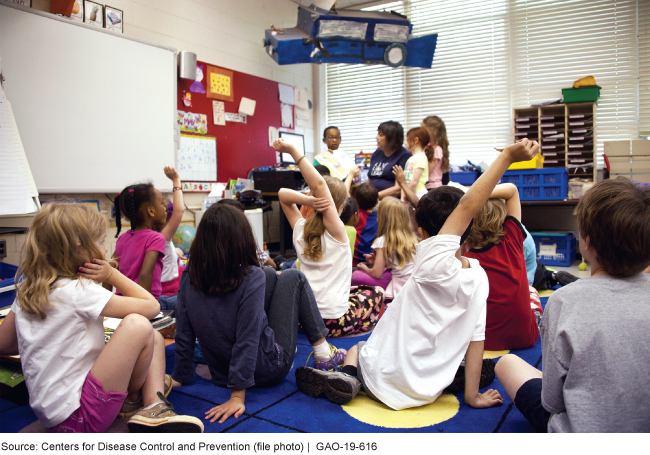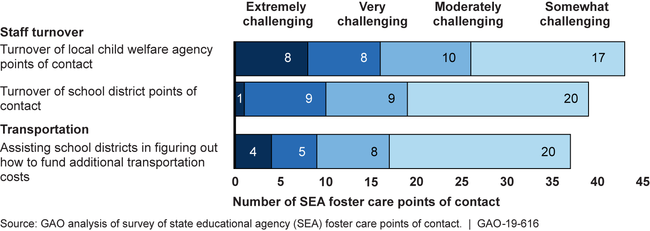Foster Care: Education Could Help States Improve Educational Stability for Youth in Foster Care
Fast Facts
Youth in foster care may often change schools, which can impair academic achievement. Federal law seeks to improve their educational stability. For example, it requires states to ensure youth stay in the original school they attended before being placed with a new family, unless doing so isn’t in their best interest.
State agency officials told us local staff turnover and the cost of transporting students to their original school were among the challenges to providing stability. They also said a way to exchange information about stability efforts would be helpful. We recommended Education develop a website where states can share information.

classroom
Highlights
What GAO Found
State educational agencies (SEAs) reported several challenges in implementing the provisions in the Every Student Succeeds Act (ESSA) related to educational stability for youth in foster care. In their responses to GAO's national survey, SEAs reported challenges, including high turnover among local educational and child welfare agency officials, and with identifying and arranging transportation to schools for students (see figure). Turnover of local staff can result in the loss of knowledge and experience needed to implement the provisions, according to SEA and local officials we interviewed. Regarding transportation, ESSA requires school districts to work with child welfare agencies to provide and fund transportation so that youth in foster care can remain in their current school when it is in their best interest. Six school district and child welfare agency officials we interviewed indicated that funding was a concern and some noted that transporting youth to their current school can result in extensive costs.
Selected Challenges SEAs Reported Related to Implementing the ESSA Educational Stability Provisions for Youth in Foster Care

The Department of Education (Education) provided technical assistance in the form of written guidance, webinars, and in-person meetings to help states implement the ESSA educational stability provisions. Education officials said they also plan to monitor state implementation of the provisions. Most SEA officials reported in GAO's survey that they would like additional assistance and more opportunities to interact with other state officials. Education plans to convene a community of practice for several states in which participants will meet regularly for several months, and is exploring other technical assistance efforts. To share information about implementing the ESSA educational stability provisions, Education maintains an email address list of SEA foster care points of contact. GAO found that the list was inaccurate and not regularly updated. Education updated the list in late summer 2019 and plans to do so quarterly. Education also provides information online, but the information is scattered across different web pages. Twenty-two SEA officials reported on GAO's survey that a clearinghouse of information would be extremely helpful. Federal standards for internal control require agencies to externally communicate necessary information in a manner that enables them to achieve their objectives. Without a dedicated web page about implementing the provisions, states may not receive the assistance they need to improve educational stability for youth in foster care.
Why GAO Did This Study
Roughly 270,000 school-aged youth were in foster care at the end of fiscal year 2017. Youth in foster care may change schools frequently, which can negatively affect their academic achievement. ESSA, enacted in 2015, reauthorized the Elementary and Secondary Education Act of 1965 and included provisions to improve educational stability for youth in foster care. These included requiring state educational agencies to ensure youth placed into foster care stay in their current school, unless it is not in their best interest to do so.
GAO was asked to review implementation of these provisions. This report examines (1) the challenges SEAs and selected school districts face implementing the ESSA educational stability provisions for youth in foster care, and (2) how Education provides technical assistance and monitors state implementation efforts. GAO surveyed SEA foster care points of contact in the 50 states, District of Columbia, and Puerto Rico and all but one state responded. In addition to interviewing federal officials, GAO interviewed selected state and local educational and child welfare agency officials, and held discussion groups with foster youth and parents, in three states selected by number of youth in foster care, among other factors. GAO also held discussion groups with officials from 14 SEAs and 5 state child welfare agencies, and reviewed relevant federal laws, regulations, guidance, and technical assistance.
Recommendations
GAO recommends that Education develop an online clearinghouse of resources. Education agreed with GAO's recommendation.
Recommendations for Executive Action
| Agency Affected | Recommendation | Status |
|---|---|---|
| Department of Education | The Secretary of Education should develop an online clearinghouse of sample documents from states and localities who wish to share them, past webinar recordings and their related documents, and links to other relevant resources that all SEAs can access. (Recommendation 1) |
Closed – Implemented
Education agreed with this recommendation and took steps to implement it. In July 2021, Education launched the Foster Care Exchange, a web-based platform for SEAs to share resources, post questions for peers to address, and build relationships with one another. Education reported that some SEAs had joined the Foster Care Exchange and tested the platform to provide suggestions for improvement. Additionally, the Foster Care Exchange lists a variety of resources offered on the platform, including non-regulatory guidance and Dear Colleague letters issued by Education and the U.S. Department of Health and Human Services (HHS), as well as relevant presentations created by Education and HHS on ensuring educational stability for children in foster care.
|
